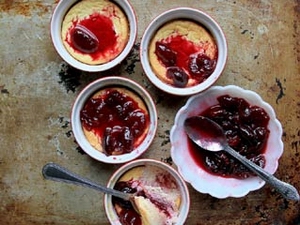 air with ricotta is one for the ages. The creamy, fresh cheese features prominently across the country's sweet and savory spectrum, lending heft and depth to pasta staples like lasagna, gnocchi, and manicotti, and enriching desserts from cheesecake to cannoli. Perhaps that's because indulging in a spoonful of the soft, mildly sweet cheese is the edible equivalent to reading a love note—at once smoothly seductive and reassuringly cozy.
air with ricotta is one for the ages. The creamy, fresh cheese features prominently across the country's sweet and savory spectrum, lending heft and depth to pasta staples like lasagna, gnocchi, and manicotti, and enriching desserts from cheesecake to cannoli. Perhaps that's because indulging in a spoonful of the soft, mildly sweet cheese is the edible equivalent to reading a love note—at once smoothly seductive and reassuringly cozy.All ricotta begins with whey, which is a byproduct of making harder types of cheese. Fittingly, the word "ricotta" literally means "recooked" in Italian. The majority of ricotta sold in the States is the soft, fresh kind made from cow's milk whey. But for those willing to search, there are other worlds of ricotta to explore including ultra-rich ricotta di bufala (made with buffalo milk), aged ricotta forte, smoky ricotta affumicata, and the firm, lightly salted ricotta salata. In recent years, fresh ricotta has become a darling of the artisanal movement, with companies like Salvatore Bklyn in New York and Narragansett Creamery in Rhode Island creating high quality versions that are thicker, fresher, and fuller flavored than the usual store-bought kind. Home cooks have also started making it in their own kitchens.
In addition to its use in traditional Italian fare, I find that ricotta makes a lovely substitute in many recipes that call for other fresh dairy products like farmer's cheese or cottage cheese. I also adore it straight up, spooned on toast and topped with anything from a drizzle of honey to a savory mash of cherry tomatoes. When in the mood for something a little more special, I make baked ricotta. Mixing ricotta with an egg and baking it in the oven transforms it into something entirely new: a complex, golden-colored thing with an airy texture and a rich mouthfeel. Served alone, it makes a lovely addition to a cheese plate or antipasto platter. But I like it best for dessert, drizzled with an orange blossom-scented cherry sauce and spooned onto biscotti or shortbread—or simply eaten on its own.





